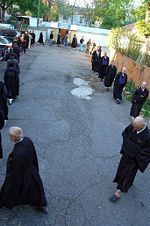
Kinhin
Encyclopedia

Zen
Zen is a school of Mahāyāna Buddhism founded by the Buddhist monk Bodhidharma. The word Zen is from the Japanese pronunciation of the Chinese word Chán , which in turn is derived from the Sanskrit word dhyāna, which can be approximately translated as "meditation" or "meditative state."Zen...
, kinhin , or , is the walking meditation
Meditation
Meditation is any form of a family of practices in which practitioners train their minds or self-induce a mode of consciousness to realize some benefit....
that is practiced between long periods of the sitting meditation known as zazen
Zazen
In Zen Buddhism, zazen is a meditative discipline practitioners perform to calm the body and the mind, and be able to concentrate enough to experience insight into the nature of existence and thereby gain enlightenment .- Significance :Zazen is considered the heart of Zen Buddhist practice...
.
Practitioners walk clockwise around a room while holding their hands in shashu (叉手), with one hand closed in a fist, while the other hand grasps or covers the fist. During walking meditation each step is taken after each full breath.
The beginning of kinhin is announced by ringing the bell twice (kinhinsho); the end by ringing once (chukaisho 抽解鐘 ‘the chime to let go and detach’).
In Chinese Zen, walking meditation is done with a wooden fish, whose rhythm one's footsteps follow. Each strike of the wooden fish is a step.
The pace of walking meditation may be slow (several steady steps per each breath) or brisk, almost to the point of jogging.
The terms consist of the Kanji
Kanji
Kanji are the adopted logographic Chinese characters hanzi that are used in the modern Japanese writing system along with hiragana , katakana , Indo Arabic numerals, and the occasional use of the Latin alphabet...
kin (経 ‘classical works
Sutra
Sūtra is an aphorism or a collection of such aphorisms in the form of a manual. Literally it means a thread or line that holds things together and is derived from the verbal root siv-, meaning to sew , as does the medical term...
’) or kyō (教 ‘religious teachings’) and hin/gyō (行 ‘walk’). Therefore if taken literally, they mean ‘walking to religious teachings.’ Although it can be translated loosely a meditative walking or walking meditation. Its literal meaning has often been claimed to be "to go straight" erroneously.
See also
- CircumambulationCircumambulationCircumambulation is the act of moving around a sacred object.Circumambulation of temples or deity images is an integral part of Hindu ritual. It is also practised in Buddhism. In Islam, circumambulation is performed around the Kaaba in Mecca, in a counter-clockwise direction...
- ZenZenZen is a school of Mahāyāna Buddhism founded by the Buddhist monk Bodhidharma. The word Zen is from the Japanese pronunciation of the Chinese word Chán , which in turn is derived from the Sanskrit word dhyāna, which can be approximately translated as "meditation" or "meditative state."Zen...
- ZazenZazenIn Zen Buddhism, zazen is a meditative discipline practitioners perform to calm the body and the mind, and be able to concentrate enough to experience insight into the nature of existence and thereby gain enlightenment .- Significance :Zazen is considered the heart of Zen Buddhist practice...
- ShikantazaShikantazais a Japanese term for zazen introduced by Rujing and associated most with the Soto school of Zen Buddhism. Ford cites on p. 224 an opinion that it is "the base of all Zen disciplines." Some people claim that according to Dōgen Zenji, shikantaza i.e...
, zazen in the Soto school

